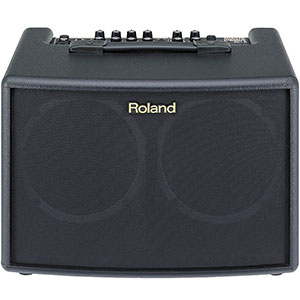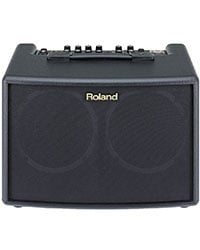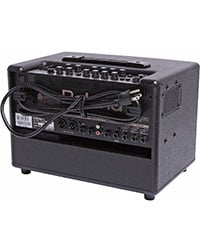- Home
- Instruments
- Gear
- Recording
- Lessons
- Reviews
- Blog


| Controls: |  |
| Features: |  |
| Performance: |  |
| Value: |  |
Roland's AC-60 has made quite a lot of ripples when it first hit the market. In an industry where size matters, they have managed to design an amp that is both light and compact. However, the performance didn't suffer at all from this scaling process. Today, Roland AC-60 is among the best compact acoustic guitar amplifiers you can lay your hands on at the moment. Let's find out exactly why this is the case.

The general layout of controls on almost any acoustic guitar amplifier is going to be more or less the same. The only real difference comes in additional features that each brand includes into their designs. This is pretty much the case with Roland AC-60. There are two channels, each with its own cluster of controls.
One channel is dedicated to instrument use only, while the other is geared more towards vocals but can still be used for guitars. Both channels come with a Volume knob and a three-band EQ as well as a Chorus button. On top of that, each one has some specific features. Guitar channel has a Pickup and Shape switch while the Mic/Line channel has a Phantom Power and Input Select switch. Lastly, there is an FX cluster that includes the Chorus and Reverb/Delay.

Roland AC-60 offers some 30 Watts of power in stereo mode. The sound is delivered through a pair of 6-1/2 inch drivers which are custom voiced for acoustic guitars. Even though this may not sound like much, AC-60 can still be used in a variety of decently sized venues without a single problem. Those speakers can get pretty loud if you need them to. The selection of effects may not be the greatest, but having a solid Chorus, Reverb and Delay goes a long way. Best of all, you can control all of these effects using a foot switch. In case you need more volume, there is a set of stereo line outs in the back, that will hook directly into a mixer.
The best thing about the Roland AC-60 has got to be the tone. This thing is fairly well balanced. Those searching for a truly flexible platform will love the subtle features of the AC-60. For example, that pickup select switch definitely makes a difference. By setting it to a mode that matches your guitar's electronics, you will get a more optimized tone right off the bat. On top of that, the digital processing unit inside the amp does a great job at rendering the tone of your guitar fairly accurately. This thing doesn't offer ultimate transparency, but the color it applies to the signal comes across as very organic in nature. Whether you are looking for something to gig with, or you just need a solid acoustic amp to use at home, Roland's AC-60 is a good way to go.
Today's market is well saturated with all kinds of amplifiers designed strictly for acoustic guitar use. In such an environment, it is fairly hard to stand out. Yet, Roland has managed to do just that. While there are many better amps out there, this one offers a type of sound that is rarely found elsewhere. Because of that, it is worth checking out.
For more info about the Roland AC-60, click here.
For more Best Acoustic Guitar Amplifiers, click here.

Wally K says
Great article, however everyone fails to remember two great features on this amp. 1) the speaker stand mount allows better projection and monitoring and 2) the available low frequency output; whitch transforms this amp into pure awsomness. thanks again
Phil says
Yea I’ve got two AC60s on poles (apart ha! ) each one fed by stereo outs of a Roland GT100 Superb sound from both my Gisbson 339 or Yamaha A5M acoustic. Solid state has really improved over past few years, although the effects on the ac60 are a bit Mickey Mouse those on the GT100 compensate for it.